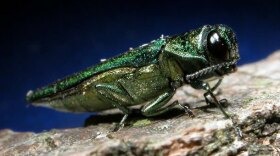If you've seen a green ribbon around a tree in the communities surrounding the Boulder area, you've been warned. Those ash trees may not survive an invasive little beetle. As part of the National Emerald Ash Borer awareness week, ribboned trees are meant to remind people just how many ash trees could be lost in Front Range communities.
"We estimate that there are over 3 million ash trees in our area," said Laura Pottorff, head of the EAB response team for Colorado. "And that's roughly 15 to 20 percent of our urban forest canopy that is susceptible to Emerald Ash Borer."
The Emerald Ash Borer remained undetected until 2013 when it was found in the city of Boulder, the furthest point west that it has been detected. The invasive beetle is native to Asia and has decimated the ash tree population across the U.S.
"On their own they [EAB] are thought to move about a half a mile a year. The insects within the city of Boulder are moving - we do see the edge of that infestation increasing. Our goal is to delay and hopefully to prevent the long distance spread of the insect through the ash wood quarantine," Pottorff said.

Loveland forestry specialist Rob MacDonald thinks EAB's spread north from Boulder is inevitable.
"The beetle can be transported as a larvae underneath the bark of the infested tree," said MacDonald. "And it could be in Loveland for all we know, we want to be proactive and avoid a large expense at one time and keep our parks as safe as we can."
"If we do nothing then certainly all the [ash] trees will die... We need time to plan and diversify our urban tree landscape."
That proactive response includes the removal of all ash trees in Loveland over the next 8 to 10 years.
Boulder's response is more organic.
In June 2015, Boulder will again deploy biological controls to try to keep EAB numbers down. In Sept, 2014 agriculture officials introduced almost 5,000 stingless, parasitic wasps from Asia.
The tiny wasps (Tetrastichus Planipennisi) are a natural parasite of the EAB.

"Our hope is that they emerged and find EAB to parasitize - lay their eggs in - and then that's where they'd stay the winter, in the EAB larvae in the trees," said John Kaltenbach, state survey coordinator for the Colorado Department of Agriculture.
Deciding whether to treat ash with insecticides or plant new trees, both expensive prospects, are at the forefront of many communities' minds which is why people abiding by the quarantine is so important, said the EAB response team's Pottorff.
"If we do nothing then certainly all the [ash] trees will die… We need time to plan and diversify our urban tree landscape," she said.






